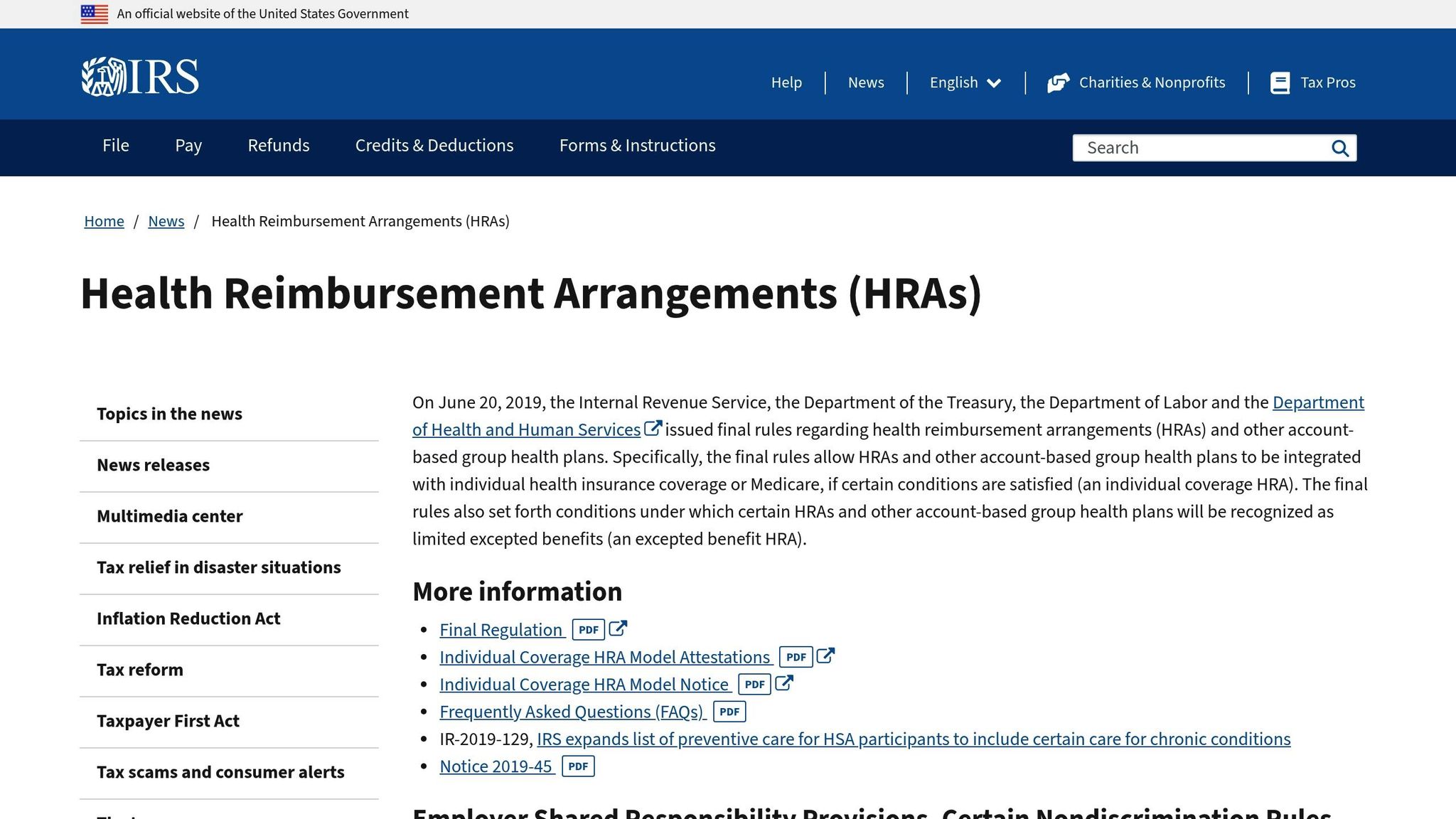Health Insurance for Multi-State Remote Teams
Navigating health insurance for multi-state remote teams is complex but crucial for attracting top talent. Learn effective strategies to simplify coverage.

Managing health insurance for remote teams across multiple states is a challenge - but it’s essential for attracting and retaining top talent. Here’s what you need to know:
- Key Issues: Different state insurance laws, varying network coverage, and federal compliance requirements make multi-state plans complex.
- Solutions: Options include multi-state group plans, state-specific plans, HRAs (like ICHRA or QSEHRA), and health stipends.
- Why It Matters: 88% of job seekers prioritize health benefits, and companies offering strong coverage see a 25% increase in applications.
Quick Tip: For flexibility and cost control, many employers choose ICHRA plans, which allow employees to pick coverage that fits their local needs.
Group health insurance vs. ICHRA

Common Multi-State Insurance Hurdles
Managing health insurance across multiple states comes with its own set of challenges. Three main areas often cause the most headaches:
State Insurance Laws
Each state has its own insurance rules, making compliance a juggling act. Employers need to deal with:
- Mandated Benefits: Some states require specific coverages that others don't.
- Rating Rules: Premiums are calculated differently depending on the state.
- Small Group Definitions: States vary in how they define small groups, which impacts eligibility for certain plans.
Network Coverage and Costs
Healthcare markets differ regionally, leading to issues with both coverage and expenses:
| Challenge | Impact |
|---|---|
| Provider Networks | Fewer in-network providers in some areas |
| Premium Variations | Costs can differ significantly by region |
| Out-of-Network Care | Higher costs for care outside the network |
Federal and State Rules
Employers must navigate both federal requirements and state-specific mandates, including:
- ACA Compliance: Meeting the essential health benefit standards under the ACA.
- Network Adequacy: States often have unique rules on provider-to-member ratios.
- Licensing: Carriers must be authorized to operate in each state.
These challenges highlight the complexities of multi-state insurance and the need for tailored solutions.
Insurance Plans for Remote Teams
Employers managing remote teams face unique challenges when it comes to compliance and coverage. Here are three main options to consider:
Group Health Plans
Traditional group health plans are a common choice for distributed teams and come in two main types:
Multi-State Plans
- Designed for teams with 50 or more employees.
- Provide consistent coverage across different locations.
- Easier to manage but come with higher premiums.
- Limited availability from insurance providers.
Single-State Plans
- Suitable for smaller teams with 1-50 employees.
- Require separate plans for each state where employees work.
- Typically more affordable than multi-state options.
- Managing multiple plans can be complicated.
| Plan Type | Employee Min | Premium Cost | Administration |
|---|---|---|---|
| Multi-State | 50+ employees | Higher | Easier |
| Single-State | 1-50 employees | Lower | More complex |
HRA Options
Health Reimbursement Arrangements (HRAs) give employers a tax-friendly way to support employees while letting them pick their own healthcare plans.
Tax Benefits:
- Contributions are tax-free for both employers and employees.
- Pre-tax contributions help reduce overall costs.
Qualified Small Employer HRA (QSEHRA)
- Designed for companies with fewer than 50 employees.
- 2024 contribution limits: $5,850 for individuals and $11,800 for families.
- Requires equal allowances for all eligible employees.
Individual Coverage HRA (ICHRA)
- Open to companies of any size.
- No cap on contribution amounts.
- Allows different allowances based on employee classes.
Health Payment Allowances
Health stipends are a simpler alternative but come with some trade-offs:
- Easier to manage compared to formal insurance plans.
- Employees can use the funds for any health-related expenses.
- Subject to taxes for both employers and employees.
- Not compliant with ACA requirements.
For many remote teams, ICHRA plans strike the right balance. They offer flexibility, predictable costs, and tax advantages while allowing employees to select coverage tailored to their local needs. This approach also aligns with job seekers' priorities - 88% value health benefits when considering employment opportunities. These solutions are a practical way to meet the diverse needs of remote teams.
Making Insurance Setup Easier
After deciding on coverage models, consider these practical solutions to simplify the process:
Working with PEOs
Professional Employer Organizations (PEOs) can help streamline multi-state health insurance management. Recent data shows that PEOs can cut HR administration costs by up to 35% for small businesses.
"Companies using TriNet's PEO services save 7-10% on health insurance costs and reduce their administrative workload by 30%"
PEOs are especially helpful for businesses with remote teams. Here’s why:
- Handle compliance and paperwork across multiple states while securing pooled rates
- Take care of all benefits-related paperwork
- Offer access to a wider range of coverage options
- Improve benefits packages, making your company more attractive to top talent
Using Software Solutions
HR platforms and benefits administration software can make managing multi-state health insurance much simpler.
"Companies using our integrated system reduced time spent on benefits administration by up to 75% and improved accuracy of benefits data by 98%"
Employee Group Benefits
To make the most of group benefits, focus on these three steps:
- Research healthcare costs in each state
- Adjust allowances to reflect regional cost differences
- Share clear, state-specific benefits details with employees
For instance, you could offer $500/month stipends in high-cost areas like San Francisco, while providing $350/month in more affordable locations like rural Iowa.
These strategies help create benefits packages that align with what job seekers are looking for.
Health Benefits for Hiring
Offering health benefits helps tackle compliance issues while aligning with what today’s workforce expects.
Meeting Job Seeker Needs
Health benefits are now a key factor for job seekers, especially for remote positions. According to SHRM's 2024 survey, 92% of job seekers view health insurance as essential when considering job offers. This number jumps to 96% for remote roles. These statistics echo the 88% prioritization of health benefits mentioned earlier.
Remote workers place high value on benefits that provide flexibility and broad coverage. Here’s what they prioritize most:
| Benefit Feature | Percentage of Remote Workers Prioritizing It |
|---|---|
| Telehealth Services | 78% |
| Mental Health Coverage | 72% |
| Wellness Programs | 65% |
Notably, companies offering coverage that complies across multiple states attract 35% more candidates for remote positions.
Standing Out to Candidates
Highlighting health benefits in job postings makes a big difference. Companies that emphasize these perks see a 25% boost in application rates.
Additionally, having a dedicated benefits page can increase candidate engagement by 30%. Providing telehealth and digital wellness tools also leads to measurable improvements:
- 22% higher productivity among remote employees
- 31% greater job satisfaction
- 27% lower stress levels
When paired with the administrative strategies discussed earlier, these benefits create a strong offering for distributed teams.
Next Steps for Employers
To implement these strategies effectively, employers can follow a clear action plan:
Start by conducting a detailed workforce assessment. Identify where your employees are located and review state-specific insurance requirements. This information will shape your approach to health insurance for remote teams.
Explore hybrid options, such as combining group plans with HRAs, as mentioned earlier. These can offer flexibility and meet diverse employee needs.
Utilize compliance automation tools to simplify benefits administration. Regularly check the program's performance to ensure it stays effective and minimizes administrative tasks.
Set up a quarterly review process to track key metrics like:
- Utilization rates
- Cost differences across regions
- Compliance with regulations
- Availability of provider networks
Work with benefits consultants who specialize in multi-state insurance to navigate regulatory updates and maintain compliance.
Finally, focus on communication tools that emphasize the benefits employees value most. Align these updates with workforce priorities discussed during compliance reviews. Conduct annual surveys with your remote teams to uncover any gaps in coverage and understand their preferences.




